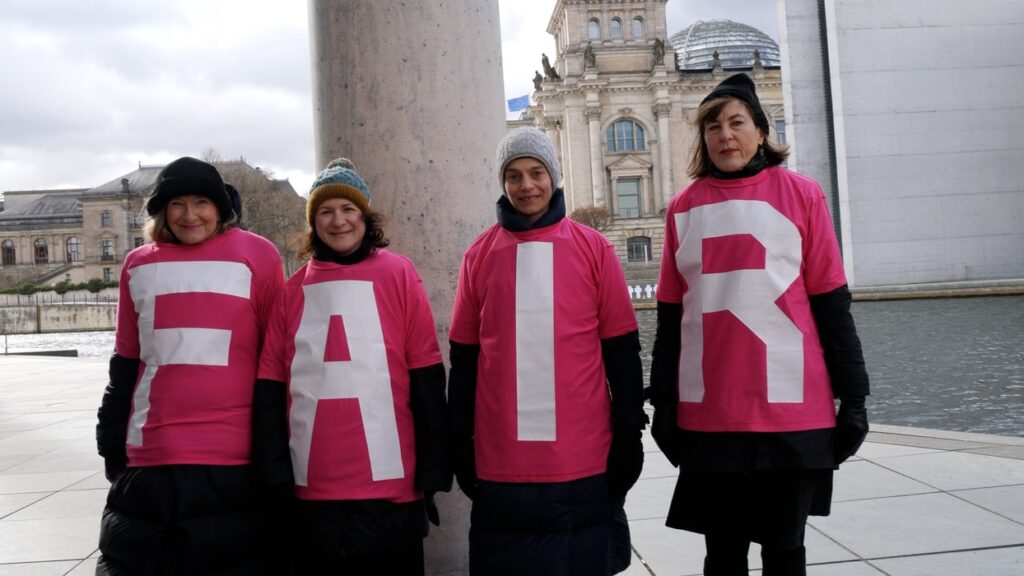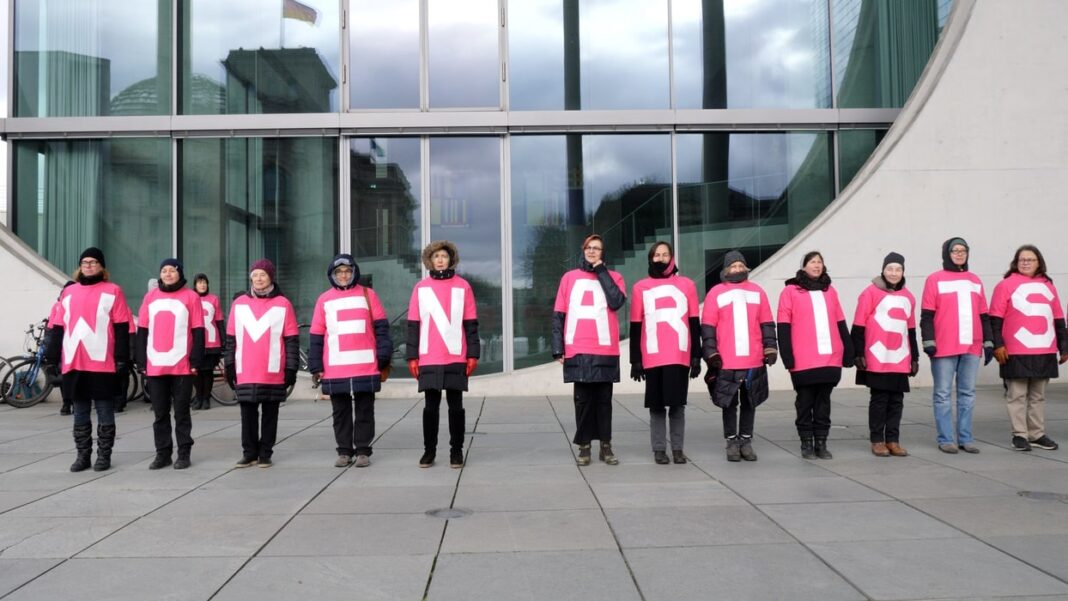The Berlin action alliance fair share! Visibility for Women Artists invites you to a symbolic campaign on the banks of the Spree in front of the Marie-Elisabeth-Lüders-Haus on International Women’s Day 2023 (8th March at noon). The fact that International Women’s Day 2023 follows Equal Pay Day in Germany on 7 March provides the theme of the protest this year.
Image above: fair share for women artists, Aktion am 08.03.2023 um 12 Uhr am Marie-Elisabeth-Lüders-Haus, Photo: Petra Weller.
Unlike in recent years in front of the houses of the National Museums in Berlin, this year fair share! is deliberately located in a place of political decision-making. The alliance demands fair and appropriate payment for the work of women artists, combined with the visibility and recognition of female potential in the visual arts.
On this year’s International Women’s Day, women artists and female cultural workers (1) go directly to the centre of political decision-making as representatives of society: Between Marie-Elisabeth-Lüders- and Paul-Löbe-Haus and facing the Bundestag, fair share! actors in pink will form new slogans in a letter scrabble, while facts, utopias, wishes and demands to politics will be articulated from the “Feminist Corner”. As a special highlight, the old raft tug Aurora with pink flags and other activists on board will attract attention on the Spree between Museum Island and Humboldthafen.
The Gender Pay Gap in the Visual Arts
Women earn 18% less than men across society (2), which means they work for free for 66 days from 1 January – until 7 March. The situation is even more drastic in the visual arts: Here, the gender pay gap is much higher at 30 % (3) – female visual artists remain unpaid for their services until 19 April in 2023. This can be attributed to structural differences and still virulent gender stereotypes in the creative industries. For example, taxpayer-subsidised museums and exhibition houses as well as federal art collections show glaring differences in the representation of female and male artists. Fair share! Research revealed that the collection of the German Bundestag (Artothek), which has been making annual purchases since 1971 (currently 175,000 €/year), only manages slightly more than 20% of works by women artists (4). In recent years, the art collection of the Federal Government has seen a significant increase in purchases of works by women artists.
However, the overall balance since the beginning of the 1970s is only just under 30 %, with a current acquisition budget of several million euros per year (5). The gaps run through all museums in Germany, even in the contemporary field, although 60 % of all art school graduates are female (6). It’s worth taking a look at the Guerrilla Girls in their current exhibition at the Hamburg Museum für Kunst und Gewerbe. The art business – both private and institutional – has been dominated by male actors for centuries. They combine power and money and still determine who or what is shown, collected and purchased. This has an influence on the state-subsidised institutions, where curators with a supposedly objective view make top-class acquisitions and put together exhibition programmes – in close cooperation with the market.

Breaking out of the vicious circle of pressure to succeed, prestige thinking and belief in the canon requires courage. We want to encourage gallery owners, curators and museum directors to reshuffle the cards in favour of women artists. The works of many women artists are less visible and are offered at much lower prices (gender discount), which creates a blatant gender pay gap. According to the Künstlersozialkasse, the average income of female artists in Germany is far below the poverty line, with caring and single-parent women being particularly affected. Political action is urgently needed here. From individual artists to the important interest groups of female visual artists, the bbk berlin and the BBK Bundesverband, demands and catalogues of measures have been developed in recent years. Proposed solutions and best practice examples are available.
But much more is needed than just raising awareness of the issue.
The action alliance fair share! Visibility for women artists
The fair share! Aktionsbündnis is a growing initiative founded by Ines Doleschal and Rachel Kohn in 2020 by female visual artists, art historians and other cultural workers and interested parties from Berlin with a supra-regional impact. The protagonists are campaigning for more visibility for women artists in the state-funded art sector. They demand a quota in all areas of contemporary art as well as an appreciation of women artists in the historical field. In addition to main actions on International Women’s Day in front of prominent museums in the city, in which works of art by women are strongly underrepresented, they stand up for little-noticed individual women artists (e.g. Anna Dorothea Therbusch), for gender parity in the awarding of grants and scholarships as well as for fairer remuneration of female art work and art-related activities in the cultural sector.
The Action Alliance also sees itself as a platform for exchange and empowerment to promote participation, diversity and the avant-garde. The aim of all actions is to increase artistic quality and diversity in the German museum and exhibition landscape, as well as fairer structures at the base of art production.
fair share! demands
• a recognition of the achievements of women artists from all centuries to the present day
• the gender-responsive design of acquisitions and exhibition activities
• eIncrease the presence of works by women artists in collections and exhibitions – in the contemporary field to 50%.
• a promotion of research projects and publications on women artists
• the revision and supplementation of art historical publications and textbooks
• the establishment of a nationwide database of women artists and a monitoring office to analyse the representation of women artists in German museums and collections, based in the department of the Minister of State for Culture and Media, following the example of the USA and UK (7)
• an introduction of significantly more and targeted funding and prizes for women artists of all ages
• the abolition of age restrictions in tenders
• Grants and scholarships for women artists with care responsibilities
• Support programmes for artists with child-rearing and care responsibilities, as well as the development of support programmes for targeted support for re-entry after family-related time off
More details on actions at
www.fairshareforwomenartists.de
The fair share! campaign is designed to be climate-friendly and is implemented in a way that conserves resources as much as possible.
The realisation is financed by private donations.
Every donation helps:
Account: Frauenmuseum Berlin e.V.
IBAN: DE26 8306 5408 0004 0227 50
Keyword: fair share! Action 8 March 2023
Sources:
(1) By artists* we mean women, lesbians, inter-non-binary and trans people.
(2) With a pay gap of 18% (2022), Germany is in fourth last position among the 27 European member states.
https://www.destatis.de/Europa/DE/Thema/Bevoelkerung-ArbeitSoziales/Arbeitsmarkt/GenderPayGap.html
(3) Gender Pay Gap 2022 in selected artistic professions in Germany; evaluation ver.di; as of 27.01.2023 (based on figures of the KSK from the 4th quarter 2022).
(4) Collection of the Bundestag (Artothek): overall, the ratio in the collection inventory is around 23 % female artists to 75 % male artists. Source: Inventory
https://www.bundestag.de/resource/blob/807584/a9a260c73b3ba86efd31988f79f324ec/bestandsverzeichnis_artothek-data.pdf
(5) Bundeskunstsammlung: overall, the ratio in the collection holdings is 27% women artists to 73% artists; in the most recent acquisition periods, it has been significantly improved. Proportions of female artists: (2012-2016) 40%, (2017-2021) 59% in regular acquisitions as well as 52% through Neustart Kultur acquisitions (2020-21), Source: Bundeskunstsammlung https://www.kunstsammlungbund.de/kunstdatenbank/2_Kuenstler/2_kuenstler_node.html;jsessionid=D70B661FF82EE369B9D060BF4EABDC11.live412 as well as exhibition catalogues.
https://www.museumsreport.de/2020/08/ankaufetat-der-bundeskunstsammlung-auf-drei-millioneneuro-erhoeht/ ; “Identity not proven”, preface to the exhibition catalogue of the same name, ed. Kunst- und Ausstellungshalle der Bundesrepublik Deutschland GmbH, 2022, ISBN 978-3-7774-3988-4, p. 8.
(6) Students (2018/19) in the visual arts are reported as 59% women. https://www.bbkberlin.de/sites/default/files/2021-03/spartenbericht-bildende-kunst-5216102219004.pdf, p. 43
(7) For the 7th consecutive year, the Freelands Foundation’s monitoring office is analysing the representation of women’s artworks in museums and collections in the United Kingdom.
https://freelandsfoundation.co.uk/research-and-publications/women-artists-report
Since 2018, the privately funded Burns-Halperin Report has been compiling data from museums and auction houses and analysing purchases of art by women, PoC and female PoC.
https://news.artnet.com/art-world/letter-from-the-editors-introducing-the-2022-burnshalperin-report-2227445






